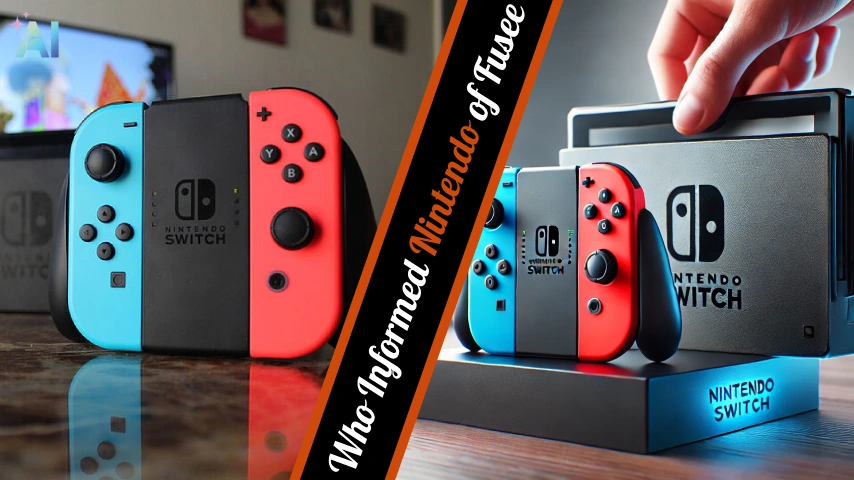Who Informed Nintendo of Fusee. The Nintendo Switch faced a major security challenge in 2018 when a vulnerability called Fusée Gelée was discovered. This exploit opened up the popular gaming console to unauthorized modifications and raised significant concerns for Nintendo. But who exactly informed Nintendo about this critical issue? Let’s dive into the story of Fusée Gelée and uncover how it came to light.
What is Fusée Gelée?
Fusée Gelée, which means “frozen rocket” in French, is a clever name for a not-so-cool problem (at least from Nintendo’s perspective). It’s a vulnerability found in the Nintendo Switch’s Nvidia Tegra X1 processor, specifically in the boot ROM. This tiny flaw turned out to be a big headache for Nintendo.
1. A Chink in the Armor
Think of Fusée Gelée as a secret passage into a fortress. It’s a weakness in the Switch’s defenses that allows hackers to sneak past all the usual security measures. This vulnerability is what we call a “coldboot” exploit, meaning it works right when the device starts up, before any of the normal security checks kick in.
2. The Unpatched Patch
Here’s the kicker: Fusée Gelée can’t be fixed with a simple software update. It’s like having a faulty lock on your front door that can’t be replaced without rebuilding the entire house. This “unpatchable” nature made it a significant threat to Nintendo’s control over their hardware.
3. A Universal Key
What made Fusée Gelée even more alarming was its scope. It affected all Nintendo Switch consoles made before a certain date. That’s millions of devices out in the wild, all potentially vulnerable to this exploit.
Who Discovered Fusée Gelée?
The person behind this groundbreaking discovery was Katherine Temkin, a security researcher working with a team called ReSwitched. Temkin and her colleagues stumbled upon this vulnerability while exploring the inner workings of the Nintendo Switch.
1. The Eureka Moment
Discovering Fusée Gelée wasn’t like finding a needle in a haystack – it was more like finding a secret door in a wall you’ve walked past a hundred times. Temkin and the ReSwitched team were poking around in the Switch’s boot process when they noticed something odd about how it handled USB connections.
2. From Discovery to Disclosure
Once they realized what they had found, Temkin and ReSwitched faced a big decision. They could keep it secret, sell it to the highest bidder, or do the responsible thing and tell Nintendo. They chose the high road.
How Does Fusée Gelée Work?
To understand Fusée Gelée, you need to know a bit about how the Nintendo Switch boots up. It’s like the process of starting your car, but with a lot more computer code involved.
1. The Exploit Mechanism
Fusée Gelée takes advantage of a flaw in the USB software stack found in the boot ROM. It’s like finding out that your car’s ignition can be tricked with a specific sequence of button presses, bypassing the need for a key.
2. Breaking the Chain of Trust
By exploiting this vulnerability, hackers can gain control of the Switch’s Boot and Power Management Processor (BPMP). This is a big deal because it happens before any security measures can kick in. It’s like sneaking into the driver’s seat before the car’s alarm system activates.
3. The Technical Nitty-Gritty
At its core, Fusée Gelée uses a buffer overflow vulnerability. Imagine pouring too much water into a cup – the excess has to go somewhere. In this case, the “somewhere” is a part of the Switch’s memory that the hackers can control.
When Was Fusée Gelée Disclosed?
The timeline of Fusée Gelée’s disclosure is almost as interesting as the exploit itself.
1. The Initial Whisper
Temkin and ReSwitched first discovered the vulnerability in early 2018. But they didn’t shout it from the rooftops right away. Instead, they started the process of responsible disclosure.
2. The Public Reveal
In April 2018, the cat was out of the bag. Fusée Gelée became public knowledge, sending shockwaves through the gaming and security communities. But this wasn’t a surprise attack on Nintendo – they had been warned.
Why is Fusée Gelée Significant?
Fusée Gelée isn’t just another hack – it’s a game-changer in the world of console security.
1. The Unpatchable Problem
What makes Fusée Gelée so significant is that it can’t be fixed with a simple update. It’s a hardware-level issue, meaning the only way to truly fix it is to change the physical chips in the Switch.
2. A Hacker’s Paradise
For the homebrew community – people who like to modify their consoles to run custom software – Fusée Gelée was a golden ticket. It opened up possibilities for running unauthorized games, emulators, and even entirely different operating systems on the Switch.
3. A Security Nightmare
For Nintendo, Fusée Gelée was a security nightmare. It meant that millions of Switches out in the world were potentially vulnerable to unauthorized modifications.
What Are the Implications for Nintendo?
Fusée Gelée posed some serious challenges for Nintendo, both in terms of security and business.
1. Security Concerns
The most immediate concern was piracy. Fusée Gelée could potentially be used to run pirated games on the Switch, which is every game company’s worst nightmare.
2. Online Gaming Integrity
There was also worry about how this might affect online gaming. If people could modify their Switches, they might be able to cheat in online games, ruining the experience for honest players.
3. Nintendo’s Response
Nintendo found themselves in a tough spot. They couldn’t patch the existing Switches, so they had to focus on future-proofing new devices. This meant revising the hardware design of the Tegra X1 chip for newer Switch models.
How Did Nintendo Learn About Fusée Gelée?
The story of how Nintendo found out about Fusée Gelée is a testament to responsible security research.
1. The Responsible Disclosure
Temkin and the ReSwitched team didn’t just publish their findings online. They followed a process called responsible disclosure. This meant informing the affected parties – in this case, Nvidia and Nintendo – before making the vulnerability public.
2. The Chain of Communication
The researchers first told Nvidia about the problem. Nvidia, recognizing the significance of the issue, then passed this information along to Nintendo. It was like a high-stakes game of telephone, but with much bigger consequences.
3. Speculation and Other Sources
While Temkin and ReSwitched were the primary source, there’s always speculation in the security world. Some wonder if Nintendo might have had insider information or if their own security team was close to discovering the vulnerability themselves.
What Are the Ethical Considerations?
The discovery and disclosure of Fusée Gelée raised some interesting ethical questions.
1. The Disclosure Dilemma
Security researchers often face a tough choice: when you find a vulnerability, do you tell the company, sell it to the highest bidder, or release it to the public? Temkin and ReSwitched chose to inform the company, which is generally considered the most ethical approach.
2. The Double-Edged Sword
While Fusée Gelée opened up possibilities for homebrew developers, it also created potential for piracy and cheating. This highlights the ongoing debate in the tech world about the balance between openness and security.
Comparison: Fusée Gelée vs. Other Switch Exploits
Fusée Gelée wasn’t the only exploit discovered for the Nintendo Switch, but it was certainly one of the most significant.
| Aspect | Fusée Gelée | Other Exploits |
|---|---|---|
| Patchability | Unpatchable | Some patchable |
| Hardware access | Required | Varies |
| Affected devices | All pre-revision | Limited models |
How Can Users Exploit Fusée Gelée?
While we don’t encourage unauthorized modifications, it’s important to understand how Fusée Gelée works.
1. Physical Access Required
Unlike some hacks that can be done remotely, Fusée Gelée requires physical access to the Switch. You can’t do this over the internet.
2. Enter Recovery Mode
The exploit involves putting the Switch into a special USB recovery mode. This is typically done by shorting certain pins on the Joy-Con connector.
3. Custom Payload Delivery
Once in recovery mode, a custom payload (a piece of code) is sent to the Switch via USB. This payload takes advantage of the Fusée Gelée vulnerability to run unauthorized code.
What Are the Potential Uses of Fusée Gelée?
Fusée Gelée opened up a world of possibilities for Switch owners, both good and potentially problematic.
1. Custom Operating Systems
Some users have managed to install entire operating systems like Linux on their Switches, turning them into mini-computers.
2. Homebrew Applications
The homebrew community has created a variety of unofficial apps and games for the Switch, enabled by exploits like Fusée Gelée.
3. Data Extraction
Fusée Gelée also allows users to access and export their saved game data, which isn’t always possible through official means.
Conclusion
Fusée Gelée represents a significant chapter in the ongoing cat-and-mouse game between console manufacturers and the hacking community. Discovered by Katherine Temkin and the ReSwitched team, this unpatchable vulnerability in the Nintendo Switch’s boot ROM posed a major challenge for Nintendo.
The responsible disclosure of Fusée Gelée to Nvidia, who then informed Nintendo, highlights the importance of ethical practices in security research. While it opened up new possibilities for homebrew developers, it also raised concerns about piracy and the integrity of online gaming.
Ultimately, Fusée Gelée forced Nintendo to revise their hardware, demonstrating the far-reaching implications of such vulnerabilities. It serves as a reminder of the complex balance between innovation, security, and user freedom in the world of gaming consoles.





